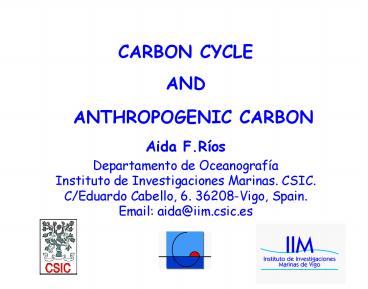CARBON CYCLE PowerPoint PPT Presentation
1 / 34
Title: CARBON CYCLE
1
CARBON CYCLE AND ANTHROPOGENIC CARBON Aida
F.Ríos Departamento de Oceanografía Instituto de
Investigaciones Marinas. CSIC. C/Eduardo
Cabello, 6. 36208-Vigo, Spain. Email
aida_at_iim.csic.es
2
- Role of the Ocean
- Distributing the solar energy.
- Regulating the CO2
- concentration of the atmosphere.
- GLOBAL CARBON CYCLE
- CO2 UPTAKE FROM THE ATMOSPHERE
- ANTHROPOGENIC CARBON
3
Air-Sea
Acumulation
Circulation
Pg 1015 g
4
- The Carbon cycle in the ocean is governed by
three factors - Physical Pump (the solubility of CO2 in
seawater) - Air-Sea interface CO2 Exchange
- Biological Pump (biochemical cycling of ocean
carbon) - Uptake of CO2 by photosynthesis in the upper
ocean and exported to the deep ocean. - Ocean water circulation
- Distribution of the oceanic CO2
5
(No Transcript)
6
(No Transcript)
7
CO2 UPTAKE FROM THE ATMOSPHERE
8
(No Transcript)
9
(No Transcript)
10
(No Transcript)
11
(Takahashi et al., 2002)
Average Net Annual Flux 2.2 0.45 Pg/yr
FCO2 0.24kS(fCO2sea-fCO2air) k
is the transfer velocity coefficient f(wind), S
is the CO2 solubility in seawater f(S, T),
0.24 is a conversion factor between units
12
(No Transcript)
13
Seasonal Sea-surface CO2 in AZORES area
14
CO2 uptake in the North Atlantic Drift Region
Average wind 5.0 ?0.6 m s-1 SST 13.8 ?0.5
ºC Wanninkohf (1992) 0.76 mol m-2
y-1 Liss and Merlivat (1986) 0.43 mol m-2
y-1
15
ANTHROPOGENIC CARBON
16
WOCE/JGOFS/OACES Global CO2 Survey 1991-1997
Total number of carbon sample locations
100,000 TCO2 estimated accuracy 2-4 µmol
kg-1 Alkalinity estimated accuracy 4-5 µmol kg-1
17
The back-calculation technique to estimate CANT
- Assuming that
- dissolved oxygen and CO2 are close to equilibrium
with the atmosphere during water mass formation. - alkalinity is not significantly affected by the
CO2 increase
CANT CT AOU/RC ½(?TA AOU/RN ) - CT?
- CT is the current total inorganic carbon
- ?TA TA - TA0, current alkalinity - preformed
alkalinity - AOU is the Apparent Oxygen Utilization O2sat
O2meas - RC (DO2/DC) and RN (DO2/DN) are stoichiometric
coefficients - CT? is the inorganic carbon in equilibrium with
the preindustrial atmosphere.
18
The back-calculation technique to estimate CANT
Improvements made by Pérez et al., 2002
- Effect of water vapour pressure on the
estimation of the pre-industrial pCO2 - Appropiate carbonic acid dissociation
constants (Mehrbach et al., 1973) - Accurate preformed alkalinity (TAº) as a
function of inorganic to organic carbon
decomposition
DC(t) CANT DCTdis
Difference is ascribed to the DCTdis
19
Atlantic
Pacific
Indian
20
(No Transcript)
21
Anthropogenic CO2 at the potential density 26.0
(a) and 27.3 (b)
22
Inventory of CANT for 1994 106 17 Pg C
(1 Pg1015 g)
Atlantic
Indian
40 ?6 Pg
22 ?3 Pg
Pacific
44 ?5 Pg
(Sabine et al, 2004)
23
Anthropogenic CO2 budget for the anthropocene
(1800-1994) and for the decades of the 1980s and
1990s (Sabine et al., 2004)
24
GEOSECS 1972-1978
Total number of carbon sample locations
6,000 TCO2 estimated accuracy 15-30 µmol
kg-1 Alkalinity estimated Accuracy 21 µmol kg-1
Average Surface Water CT Increase in 2000 1.2
µmol kg-1
25
Effects of CO2 enrichment on marine phytoplankton
Effect on biocalcification
Riebesell, Zondervan, Rost, Tortell, Zeebe, Morel
(2000) Nature 497, 364
26
Impact on sea urchin larvaeFrom Y. Shiriyama
27
Threshold temperature above which bleaching
manifests itself (1-2ºC above the long-term
summer maximum temperatures Besides they are
also affected by the pH variations
Hoegh-Guldberg (1999)
28
Animal species intolerant to CO2 oscillations
Squid Illex illecebrosusLolliguncula
brevisLoligo pealei
H. Poertner
29
- CONCLUSIONS
- Beneficial effect on the atmospheric CO2 uptake
by the oceans because it mitigate the climate
change. - It seems that CO2 uptake is decreasing due to a
decrease in the buffering effect by the ocean. - Negative effect because of the oceans become more
acid, affecting the shell-forming species. - To obtain reliable CO2 uptake rates and global
ocean inventory of anthropogenic CO2, good carbon
measurements and related tracer are needed. This
is the aim of this Summer School.
30
CARBO-OCEAN Integrated Project at 5
years Coordinator C. Heinze Overall goal To
get an accurate assessment of the marine carbon
sources and sinks in the Atlantic and Southern
Oceans
31
- 3 Modules
- Description
- Understanding
- Prediction
- 5 Core Themes
- Surface
- Water column
- Regional
- Feedback
- Future development
32
Theme 1
Surface
33
Theme 2
Water column
34
Theme 3
Regional

